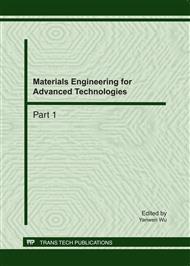p.478
p.484
p.490
p.496
p.502
p.507
p.513
p.519
p.523
GC/MS Determination of Bioactive Components of Waste Leaves from Platanus × acerifolia (Ait.) Willd
Abstract:
Platanus × acerifolia (Ait.) Willd has high tolerance to environment stress, and a long history of utilization and plantation in China. It is important to recover and utilize the polluting waste leaves from Platanus × acerifolia (Ait.) Willd in order to separate top value-added bioactive components, hence the chemical components of benzene/ethanol extractive of waste leaves from Platanus × acerifolia (Ait.) Willd by means of GC/MS. Relative content of each component was determined by area normalization, and 19 compounds representing 92.35 % of the extractives were identified. The most abundant constituents were as: The analytical result showed that the main components of benzene-methanol extractive of freeze-dried waste leaves from Platanus × acerifolia (Ait.) Willd by GC/MS analysis were 1,3-Dioxane (24.95%), Ethylbenzene (19.03%), p-Xylene (16.02%), Benzene, 1,2-dimethyl- (6.64%), Indane (4.00%), Heptanal (3.89%), 1-Methyl-2-(4-nitrophenyl)benzimid (3.39%), (11H)Pyrido[3',2':4,5]imidazo[2,1- (3.25%), 10-Methylnonadecane (3.00%), Benzene, 1-ethyl-3-methyl- (2.91%), Benzene, 1-ethyl-3-methyl- (2.65%), Benzene, 1-ethyl-2-methyl- (2.46%), 2,5-Cyclohexadien-1-one, 2,5-dimethyl- (1.74%), Docosane, 7-butyl- (1.52%), 1-Amino-2-(hydroxymethyl)anthraqui (1.47%), Acetaldehyde - (0.89%), etc. Our result by GC/MS firstly showed that the benzene-methanol extractives of freeze-dried waste leaves from Platanus × acerifolia (Ait.) Willd can be used as top value-added materials of medicines, cosmetics and industrial solvents.
Info:
Periodical:
Pages:
502-506
Citation:
Online since:
June 2011
Authors:
Price:
Сopyright:
© 2011 Trans Tech Publications Ltd. All Rights Reserved
Share:
Citation:


